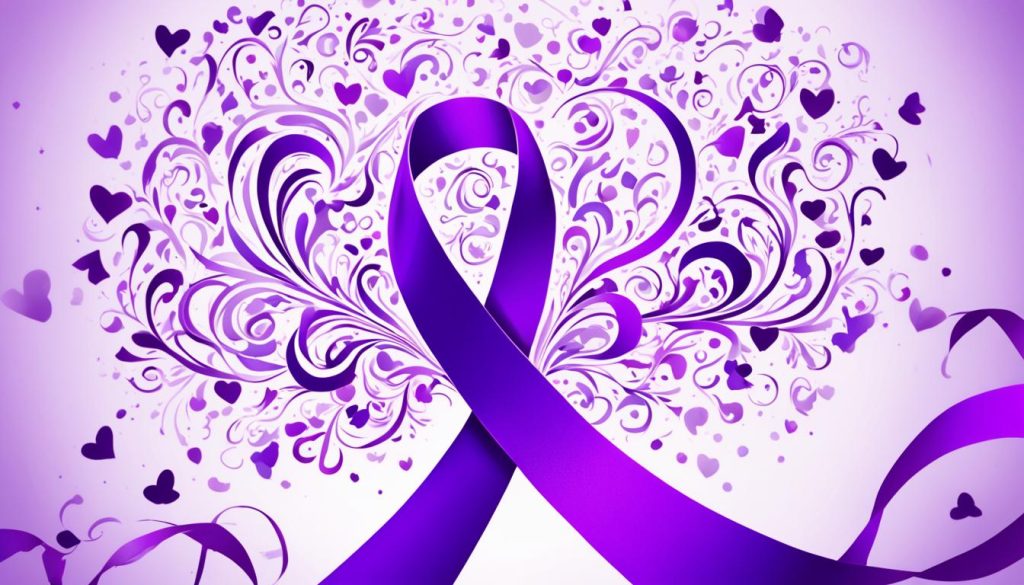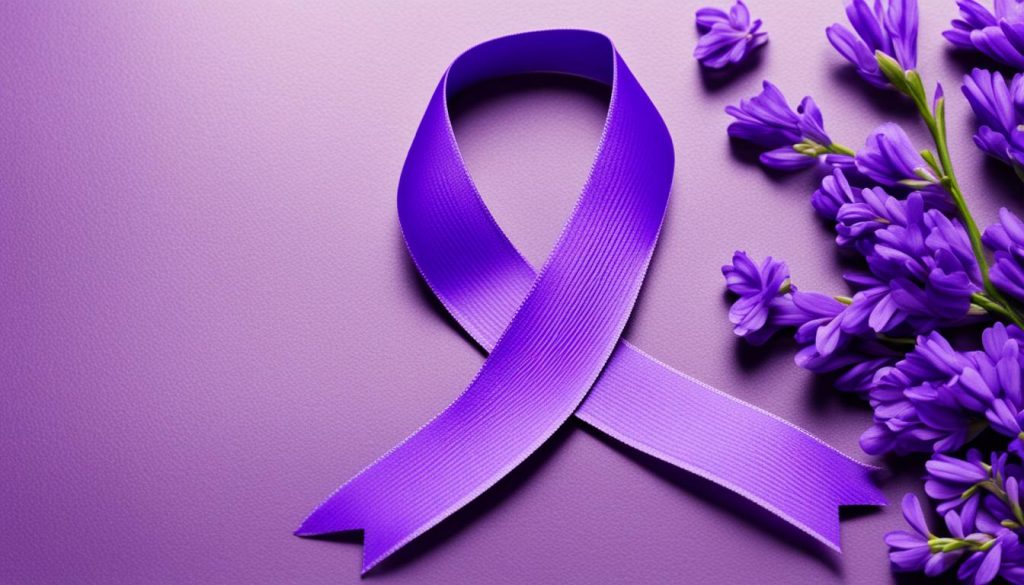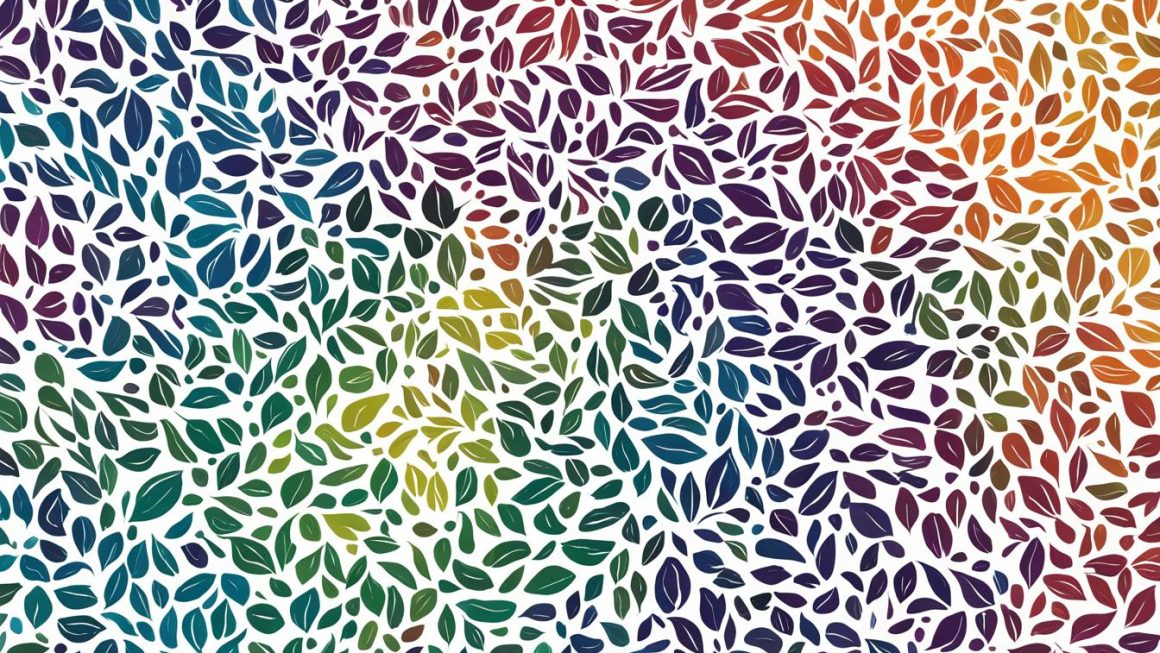When it comes to raising awareness for mental health, a particular color has come to symbolize support and solidarity. The mental health awareness color is green. By wearing a green ribbon or displaying the color green, you can join the movement and show your commitment to promoting good mental health for all.
Mental health is a crucial aspect of overall well-being, and it is important to break the stigma surrounding mental health issues. The green ribbon serves as a visual reminder that we are not alone in our struggles and that there is a supportive community around us.
Key Takeaways:
- The mental health awareness color is green.
- Wearing a green ribbon or displaying the color green shows support for individuals struggling with mental health issues.
- The green ribbon represents solidarity and a commitment to promoting good mental health for all.
The Significance of Awareness Ribbons
Awareness ribbons have become powerful symbols of support and solidarity for various causes. These ribbons serve as visual reminders, sparking conversations that help raise awareness and promote understanding of social, health, and humanitarian issues. Each colored ribbon has a specific meaning, representing a particular cause or condition. The use of awareness ribbons has evolved over time, and they play a crucial role in advocating for positive change and building empathy within communities.
These ribbons serve as a catalyst for change, drawing attention to important topics and encouraging individuals to take action. By wearing a ribbon, you not only show your support for a specific cause but also create an opportunity for dialogue and education. These simple yet impactful symbols have the potential to spark conversations that lead to increased awareness, understanding, and empathy.
The history of awareness ribbons dates back to the early 20th century when they were first used to raise awareness for issues such as HIV/AIDS. Over time, awareness ribbons gained popularity and became associated with various causes, each with its own unique color and meaning. Today, awareness ribbons are recognized globally and have become a universal symbol of support and solidarity.
Wearing an awareness ribbon not only demonstrates your commitment to a cause but also helps create a sense of unity among individuals who share a common passion for advocating for positive change. These ribbons serve as a constant reminder of the importance of addressing societal challenges and working towards a better future.
| Ribbon Color | Meaning |
|---|---|
| Red | Symbolizes HIV/AIDS awareness, as well as other causes such as blood cancers, cardiovascular disease, substance abuse, and congenital heart defects. |
| Yellow | Represents support for active duty U.S. military troops, as well as causes like suicide prevention, missing children awareness, bladder cancer, and liver disease awareness. |
| Blue | Holds various meanings, including autism awareness, anti-bullying, colon cancer awareness, education, child abuse prevention, respiratory diseases, arthritis, and mental health awareness. |
| Purple | Raises awareness for conditions such as pancreatic cancer, epilepsy, lupus, Alzheimer’s disease, fibromyalgia, ADHD, domestic violence, sarcoidosis, and Crohn’s disease. |
| Green | Symbolizes mental health awareness, support for individuals with conditions like bipolar disorder, cerebral palsy, and depression, and environmental causes. |
| Orange | Used to show support for individuals with conditions like leukemia, multiple sclerosis, spinal cancer, as well as suicide prevention, substance abuse awareness, and cultural diversity. |
| Pink | Most widely recognized as a symbol of breast cancer awareness, as well as nursing mothers and birth parents. |
| Turquoise | Raised for addiction recovery, congenital diaphragmatic hernia, interstitial cystitis, Native American rights, and reparations. |
Red Ribbons and Their Meanings
Red ribbons carry significant meanings and are associated with various causes that deserve attention and support. Understanding the symbolism behind the red ribbon can help create awareness and foster change.
The red ribbon is most commonly recognized as a symbol of HIV/AIDS awareness and prevention. By wearing a red ribbon, you show solidarity with those affected by this global health issue and advocate for education, support, and prevention methods.
However, the red ribbon represents more than just HIV/AIDS awareness. It also symbolizes awareness for other important causes:
- Blood Cancers: Wearing a red ribbon raises awareness about blood cancers such as leukemia, lymphoma, and multiple myeloma. It serves as a reminder to support individuals undergoing treatment and to promote research for better treatments and ultimately find a cure.
- Cardiovascular Disease: Red ribbons also represent awareness for cardiovascular diseases, including heart disease and stroke. By wearing a red ribbon, you show support for heart health and the importance of prevention through healthy lifestyle choices.
- Substance Abuse: Red ribbons are a symbol of support for individuals struggling with substance abuse. They signify solidarity, advocacy, and the need for resources and treatment options.
- Congenital Heart Defects: Red ribbons raise awareness about congenital heart defects, which are structural problems in the heart present at birth. By wearing a red ribbon, you support individuals and families affected by these conditions and help promote access to care and research.
To truly make an impact, it is vital to understand the red ribbon’s diverse symbolism and take action to support those affected by the associated conditions. By wearing a red ribbon, you spread awareness, promote support, and contribute to education, prevention, and research efforts.
Yellow Ribbons and Their Meanings
The yellow ribbon holds significant meaning and serves as a symbol of support for various causes. By wearing or displaying a yellow ribbon, individuals demonstrate solidarity and raise awareness for important issues. Here are some of the meanings associated with the yellow ribbon:
- Support for active duty U.S. military troops: The yellow ribbon is widely recognized as a symbol of support for those serving in the armed forces. It represents gratitude and acknowledgment of the sacrifices made by individuals and their families.
- Suicide prevention: Yellow ribbons are used to raise awareness about the importance of suicide prevention. They serve as a reminder to promote mental health and support those who may be struggling.
- Missing children awareness: The yellow ribbon is also used to raise awareness about missing children and highlight the significance of child protection efforts. It serves as a symbol of hope and solidarity for families who are seeking their loved ones.
- Bladder cancer awareness: Wearing a yellow ribbon helps raise awareness for bladder cancer, a condition that affects thousands of individuals. It supports ongoing research, education, and advocacy for early detection and treatment.
- Liver disease awareness: The yellow ribbon is associated with liver disease awareness, including conditions such as hepatitis, cirrhosis, and liver cancer. It signifies solidarity with individuals affected by these diseases and the need for support and early intervention.
Wearing a yellow ribbon showcases your commitment to these causes and your support for individuals who have been impacted. It sparks conversations and fosters understanding, ultimately contributing to positive change and increased awareness.
Yellow Ribbons and Their Meanings
| Cause | Meaning |
|---|---|
| Support for active duty U.S. military troops | Demonstrates gratitude and solidarity |
| Suicide prevention | Raises awareness for mental health andsupport for individuals at risk |
| Missing children awareness | Symbolizes hope and unity in the search for missing children |
| Bladder cancer awareness | Promotes early detection, treatment, and support |
| Liver disease awareness | Raises awareness for liver diseases and the need for support |
Blue Ribbons and Their Meanings
Blue ribbons hold various meanings and are associated with a range of causes that promote awareness, support, and advocacy. By wearing a blue ribbon, you can contribute to these important issues and make a difference.
Causes Associated with Blue Ribbons:
- Autism: Blue ribbons represent support and acceptance for individuals on the autism spectrum, as well as their families and caregivers.
- Anti-bullying: Wearing a blue ribbon signifies a commitment to raising awareness and taking action against bullying behaviors.
- Colon Cancer: Blue ribbons symbolize the fight against colon cancer, promoting early detection, prevention, and treatment.
- Education: Blue ribbons are a symbol of support for quality education and equitable opportunities for all students.
- Child Abuse Prevention: Wearing a blue ribbon raises awareness about child abuse prevention and the importance of creating safe environments for children.
- Mental Health Awareness: Blue ribbons serve as a symbol of support for individuals with mental health conditions, highlighting the need for understanding, compassion, and access to resources.
- Respiratory Diseases: Blue ribbons represent different respiratory diseases such as asthma, chronic obstructive pulmonary disease (COPD), and lung cancer, promoting awareness, prevention, and support.
- Arthritis: Wearing a blue ribbon shows solidarity with individuals living with arthritis, supporting research, treatment, and improving the quality of life for those affected.
By wearing a blue ribbon, you play a vital role in fostering understanding, supporting affected individuals, and advocating for positive change in these important areas.
Purple Ribbons and Their Meanings
Purple ribbons serve as powerful symbols in raising awareness for a wide range of conditions and issues. By wearing a purple ribbon, you show your support for individuals affected by these challenges and help advocate for research, education, and support services.
Cancer Awareness
One significant meaning of purple ribbons is their association with various types of cancer. Purple ribbons represent awareness for pancreatic cancer, a disease that affects the pancreas and often goes undetected until later stages. Wearing a purple ribbon shows solidarity with pancreatic cancer patients and their families, highlighting the importance of early detection, treatment options, and ongoing research efforts.

Neurological Disorders
Purple ribbons also raise awareness for neurological disorders such as epilepsy. Epilepsy is a chronic condition characterized by recurrent seizures, affecting individuals of all ages. Wearing a purple ribbon signifies support for those with epilepsy, encourages understanding, and reinforces the need for continued research and access to treatment options.
Autoimmune Diseases
Lupus, an autoimmune disease, is another condition represented by the purple ribbon. Lupus causes the body’s immune system to mistakenly attack healthy tissues and organs. Wearing a purple ribbon raises awareness for lupus and supports individuals living with the disease. It also emphasizes the need for improved diagnosis methods, treatment options, and community understanding.
Alzheimer’s Disease and Dementia
Purple ribbons symbolize Alzheimer’s disease and dementia awareness. These conditions affect memory, cognition, and daily functioning, often requiring specialized care and support. Wearing a purple ribbon shows solidarity with individuals living with Alzheimer’s and dementia, and advocates for improved care, research funding, and resources for caregivers.
Other Causes
Purple ribbons also reflect awareness for various other causes, including:
- ADHD (Attention-Deficit/Hyperactivity Disorder), promoting understanding and support for individuals affected by this neurodevelopmental disorder.
- Domestic violence, promoting awareness, prevention, and support for victims and survivors.
- Sarcoidosis, a multisystemic inflammatory disease, emphasizing the need for research, treatment options, and community support.
- Crohn’s disease, a chronic inflammatory bowel disease (IBD), advocating for improved management, research, and public awareness.
Wearing a purple ribbon for these causes demonstrates your commitment to supporting individuals affected by these conditions and highlights the importance of research, education, and initiatives aimed at creating a better future for all.
Green Ribbons and Their Meanings
Green ribbons have significant symbolism in raising awareness for mental health. By wearing a green ribbon, you show your support for individuals with conditions like bipolar disorder, cerebral palsy, and depression. The green ribbon serves as a visual reminder of our commitment to promoting good mental health for all.
Not only do green ribbons represent mental health awareness, but they also support environmental causes and promote organ donation. By wearing a green ribbon, you demonstrate your understanding, compassion, and dedication to mental health advocacy.
| Symbolism | Cause |
|---|---|
| Individuals with mental health conditions | Bipolar disorder, cerebral palsy, depression, and other mental health conditions |
| Environmental causes | Advocacy for environmental conservation and sustainable practices |
| Organ donation awareness | Promoting organ donation and transplantation |
Wearing a green ribbon is more than just an accessory; it’s a statement of solidarity and support. It sends a powerful message that you recognize the importance of mental health awareness and the need to break societal stigmas.
“Wearing a green ribbon promotes understanding, compassion, and a commitment to mental health advocacy.”
Orange Ribbons and Their Meanings
Orange ribbons are a powerful symbol of support and awareness for a variety of important causes. By wearing an orange ribbon, you can show your commitment to making a difference and promoting meaningful change.
The orange ribbon represents solidarity with individuals who face challenges such as leukemia, multiple sclerosis, and spinal cancer. It serves as a visual reminder of the strength and resilience of those affected by these conditions.
Additionally, orange ribbons symbolize the pursuit of suicide prevention and substance abuse awareness. By wearing an orange ribbon, you can help spark conversations and raise awareness about these critical issues that impact countless lives.
Furthermore, orange ribbons also stand for cultural diversity. In a world that thrives on unity and understanding, the orange ribbon serves as a powerful reminder to embrace and celebrate the richness of different cultures and traditions.
Regardless of the cause represented, wearing an orange ribbon signifies your dedication to supporting those affected and your determination to create awareness and foster positive change. By prominently displaying this symbol, you become an advocate for these important causes and contribute to a more compassionate and inclusive society.
| Orange Ribbon Meanings | Ribbon Symbolism | Ribbon Awareness |
|---|---|---|
| Leukemia, multiple sclerosis, spinal cancer | Strength, resilience | To support individuals facing these challenges and raise awareness |
| Suicide prevention, substance abuse awareness | Life-saving efforts, raising consciousness | To promote understanding and provide support |
| Cultural diversity | Unity, appreciation for different cultures | To celebrate diversity and create a more inclusive society |
“Wearing an orange ribbon signifies a commitment to supporting those affected and raising awareness for these important causes.”
Pink Ribbons and Their Meanings
Pink ribbons have become widely recognized as a symbol of breast cancer awareness. This powerful symbol not only represents the fight against breast cancer but also serves as a reminder of the importance of early detection, treatment, and ongoing research.
In addition to breast cancer awareness, pink ribbons also symbolize support for nursing mothers and birth parents. By wearing a pink ribbon, you show solidarity with these individuals and acknowledge the challenges they may face.
Wearing a pink ribbon is a powerful way to demonstrate support for individuals affected by breast cancer and to raise awareness within your community. Together, we can promote early detection, provide vital support, and work towards finding a cure.
Significance of Pink Ribbons
“The pink ribbon is a symbol of hope, strength, and dedication to the fight against breast cancer. By wearing it, we show our commitment to supporting individuals affected by this disease and working towards a future free from breast cancer.”
Join the movement and wear a pink ribbon to show your support for breast cancer awareness and research.
Turquoise Ribbons and Their Meanings
Turquoise ribbons hold significant meanings and symbolize awareness for various conditions and causes. Wearing a turquoise ribbon represents support for individuals affected by addiction recovery, congenital diaphragmatic hernia, and interstitial cystitis. It also serves as a symbol for Native American rights and reparations, highlighting the importance of social justice and equality.
The turquoise ribbon serves as a visual reminder to promote understanding, research, education, and support services for individuals impacted by these conditions. By wearing a turquoise ribbon, you show your commitment to raising awareness and stand in solidarity with those affected, advocating for their rights and well-being.
Examples of Turquoise Ribbon Awareness:
- Addicition recovery awareness
- Congenital diaphragmatic hernia awareness
- Interstitial cystitis awareness
- Native American rights and reparations
“Wearing a turquoise ribbon signifies support for individuals affected by addiction recovery, congenital diaphragmatic hernia, and interstitial cystitis.”
Turquoise Ribbon Symbolism:
- Support for individuals affected by addiction recovery, congenital diaphragmatic hernia, and interstitial cystitis
- Advocacy for Native American rights and reparations
- Commitment to raising awareness and promoting research and education
- Solidarity with marginalized communities and social justice causes
Lavender Ribbons and Their Meanings
Lavender ribbons hold significant meanings in raising awareness for cancer, epilepsy, and foster care. By wearing a lavender ribbon, you show your support and solidarity for individuals affected by these conditions and emphasize the importance of early detection, treatment, and support services.
The lavender ribbon symbolizes hope, compassion, and strength for those fighting cancer. It serves as a reminder to spread awareness about this devastating disease and the need for ongoing research, prevention, and improved treatment options.
Epilepsy, a neurological disorder characterized by recurring seizures, is also represented by the lavender ribbon. Wearing this ribbon signifies your support for individuals living with epilepsy, as well as the importance of promoting understanding, education, and access to proper medical care.
Additionally, the lavender ribbon raises awareness for foster care and the thousands of children in need of loving homes and stable environments. By wearing a lavender ribbon, you show your commitment to supporting foster care initiatives, advocating for improved foster care systems, and promoting positive outcomes for vulnerable children.
Join the movement and wear a lavender ribbon to show your support for individuals affected by cancer, epilepsy, and foster care. Together, we can make a difference in their lives and contribute to a brighter future.
Violet Ribbons and Their Meanings
Violet ribbons hold significant meaning in raising awareness for Hodgkin’s disease and testicular cancer. By wearing a violet ribbon, you show your support for individuals affected by these conditions and emphasize the importance of early detection, treatment, and research.
The violet ribbon symbolizes hope, strength, and perseverance in the face of these diseases. It serves as a reminder to stay vigilant and proactive in maintaining good health. Wearing a violet ribbon helps start conversations about these conditions, promoting understanding and compassion within communities.
With its vibrant and unique color, the violet ribbon stands out as a visual representation of support and awareness. It calls attention to the challenges faced by those living with Hodgkin’s disease and testicular cancer, and encourages others to join the cause. By uniting under the violet ribbon, we can inspire hope, drive change, and ultimately improve the lives of individuals affected by these conditions.

| Cause | Symbolism |
|---|---|
| Hodgkin’s disease awareness | Support for individuals with Hodgkin’s disease and advocacy for research and treatment |
| Testicular cancer awareness | Support for individuals battling testicular cancer and the importance of early detection |
Let the violet ribbon be a powerful symbol of your commitment to raising awareness for Hodgkin’s disease and testicular cancer. Wear it proudly to show your support, spark conversations, and make a difference in the lives of those affected.
Conclusion
Awareness ribbons play a crucial role in promoting support and solidarity for various causes. By wearing or displaying a ribbon that represents a specific cause, you can raise awareness, foster understanding, and show your support for individuals affected by the associated condition or issue.
One such symbol is the green ribbon, which represents mental health awareness. Wearing a green ribbon serves as a visible reminder of our commitment to promoting good mental health for all. It signifies that you stand in solidarity with those facing mental health challenges and encourages conversations about mental well-being.
Whether it’s the red ribbon for HIV/AIDS awareness, the yellow ribbon for military support, the blue ribbon for autism, or the purple ribbon for epilepsy, each ribbon holds its own meaning and significance. By donning these ribbons, you can contribute to a greater understanding of these important issues and demonstrate your support and empathy for those affected.
Show your support and wear a ribbon that resonates with you. Let your ribbon be a catalyst for change, raising awareness, and promoting support and solidarity. Together, we can make a difference.



